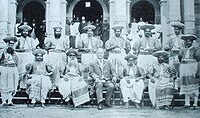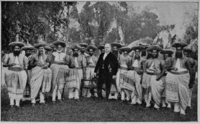This is an old revision of this page, as edited by Keith D (talk | contribs) at 12:41, 12 October 2021 (Jul. -> July). The present address (URL) is a permanent link to this revision, which may differ significantly from the current revision.
Revision as of 12:41, 12 October 2021 by Keith D (talk | contribs) (Jul. -> July)(diff) ← Previous revision | Latest revision (diff) | Newer revision → (diff) Sinhala aristrocratic subcaste of the Govigamas, traditionally of the Kandy region in Sri Lanka

Radala refers to a small minority group in Sri Lanka in the former provinces of the Kingdom of Kandy, who are either descendants of chiefs and courtiers of the King of Kandy or descendants of native headmen appointed by the British colonial administration following the Uva Rebellion in 1818.
Radala's often refer to themselves as the aristocracy of the Kingdom of Kandy and claim the term came into use following the throne of the Kingdom of Kandy went to the Nayak Dynasty, whose family members constituted the royalty of the kingdom. The British referred to this group as chiefs who held the high offices of state such as Adigar and Dissava, which appointments were not hereditary and these individuals could not assend to the throne as the Nayak royalty could. This group of chiefs were instrumental in deposing the last king of Kandy, Sri Vikrama Rajasinha and signing the Kandyan Convention in 1815 which transferred the Kingdom of Kandy on to the British crown. John D'Oyly does not make any reference to a particular group called Radala in his writings. This group came to dominate national politics in the post-independence era, under the former Prime Minister Sirima Bandaranaike a direct descended of one of the signatories of the Kandyan Convention.
History
Kandyan Kingdom

The offspring of Kandyan Kings from concubines of non-royal blood of the harem known as Yakadadoli received appointments in court and in the provinces. The status disparity between royalty and the Radalas was small and the Radalas only had to call themselves 'serviles' (gettás) in the presence of the king and prostrated only at ritual ceremonies to demonstrate their lower status vis a vis the king. This practice continued into the British period and was abhorred as a degrading form of ancient tyranny and abolished by the British in 1818 under the proclamation of November 21, 1818 by Governor Robert Brownrigg. Apart from having to continuously dress in full in the presence of the King, the Radalas didn't have to rise from their seats like other commoners when the king's dirty linen was taken past them (A Historical Relation of Ceylon, Robert Knox, Part II, Chapter2). They were permitted to use their own ancestral and military insignia, swords, umbrellas, jewellery and wear shoes. Some Chiefs were merely personal attendants of the King. The Diyawadana Nilame was the King's personal valet responsible for bathing and dressing of the King.
The traditional Kandyan Radala of the past had considered themselves to be an exclusive caste and not part of the Govigama caste. Bryce Ryan observed as recent as 1953 that Radalas repudiated Govi connections and that the status of the Govi caste still remains relatively low in villages where the Radala existed (Caste in Modern Ceylon, page 99). The demand by the Kandyan Radala elite for a separate federal state in independent Ceylon, the representations made to the Donoughmore Commission and the formation of the Kandyan National Assembly (KNA) as recently as in 1924 demonstrates the reluctance of the Kandyan elite to be governed by arriviste low country Govigama families of dubious ancestry, which was to be the inevitable outcome of the British departure.
The Radala's as a community had had significant power over the throne of Kandy. This was the case as the last Nayakar King of Kandy, Sri Wickrema Rajasinha lost his throne soon after losing the military and administrative support of the Radalas for his cruelty towards his subjects, and for his licentious forced affairs with their wives and daughters.
The British Radalas


After capturing the Kandyan provinces in 1815, the British soon created an extensive class of 'New Radalas' in the Kandyan territory to assist them with its administration. As much as the British created class of Sri Lankan Mudaliyars in the low-country, this class too was composed of natives who were most likely to serve the British, Govigama families that had either cooperated with the British to capture Kandy or from miscellaneous lower caste families that had joined the British cause later for financial purposes.
They were all from anglicised families and were considered pillars of the Anglican church. They had English first names and their children too were similarly named. In addition they had a string of high sounding Sinhala names taken on when receiving their appointment from the British. Some of these names were from Kandyan families that had ceased to exist or were severely reduced, and from purported ancestors with dubious connections. The new British-made Radala class were immediately rejected by the original Kandyan Radalas. The new British-made Radalas tried unsuccessfully to rename themselves with the names of famous Kandyan Radalas such as the Keppitipolas, Mampitiyas, and Ranarajas. All these attempts were rejected by the British for fear of further dissent by the original Kandyan Radalas.
Many of these 'New Radala' families had low-country origins and many intermarried with the anglicized low country Mudaliyar class, and in many cases several times with one family in an apparent bid to create some exclusivity. Most were from the Sabaragamuwa province and not from interior parts of the Kandyan provinces that were less susceptible to British influence. These New Radals too resembled English country squires and most of them had received large land grants from the British for their servitude. Their residences were of unprecedented scale, built in the 19th century in the British colonial style and were referred to by the Tamil word Walauu or Walvoo.
They generally held 'Rate Mahattaya' or local administrator positions and had studied under leading Anglican Priests at the Anglican missionary schools S.Thomas' College, Trinity College (Kandy) and High school Ratnapura, which were institutions set up by the British specifically for producing a class of loyal, local, second level administrators. With each successive batch of British Civil Servants and Governors arriving in Sri Lanka, this propped up pseudo-aristocratic group tried harder and harder to generate a greater and higher appearance of nobility and Kandyan lineage.
However the descendants of the original Kandyan Radalas rarely marry the descendants of British-made Radalas or any other Govigamas for that matter. If any of them do, those people and all their descendants are classified as lower-caste outcastes by the descendants of the original Radala community.
20th century

The marriage in 1910 to Kandyan 'New Radala' Mollie Dunuwila, newspaper magnate D. R. Wijewardena's marriage in 1916 to a Meedeniya and finally S. W. R. D. Bandaranayake's marriage in 1940 to Sirimavo Ratwatte appear to have muted some of the antipathy and created the common political power block that has ruled the country since independence from the British in 1948. The Radalas however are still relatively endogamous and even as at date would only rarely marry an average Govigama in an arranged marriage.
Nilame
Nilame word referred to the court officials. The names of the officials were given according to their position in each dynasty. Due to the development of language and change of requirements, the positions were changed and its names were changed. In Kandyan dynasty there are several officials in the court or "Raja wasala". They were Adigar and Dissava.
Notable members
- William Gopallawa, MBE - First President of Sri Lanka and last Governor-General of Ceylon
- Sirimavo Ratwatte Dias Bandaranaike - Former Prime Minister of Sri Lanka and first female Prime Minister in the world
- Keppetipola Disawe - Leader of the Uva Rebellion
- P. B. Bulankulame Dissava - former Cabinet Minister of Land and Land Development
- Harris Leuke Ratwatte - Member of the State Council of Ceylon, Parliament and the Senate of Ceylon and Diyawadana Nilame
- General Anuruddha Ratwatte - former Cabinet Minister and acting Diyawadana Nilame
- Major General Richard Udugama, MBE - Former Commander of the Ceylon Army and Member of Parliament
- Lieutenant General Denzil Kobbekaduwa - A former Overall Operations Commander, Northern Sector.
- Hector Kobbekaduwa - former Cabinet Minister and 1982 presidential candidate of the Sri Lanka Freedom Party
- Ranjan Madugalle - former Test Cricket Captain of Sri -Lanka and current Chief Match Referee of the International Cricket Council
- J. H. Meedeniya Adigar - Legislator
- Major E. A. Nugawela - former Cabinet Minister of Education (of the first cabinet 1947), Member of Parliament & State Council
- Hon P. B. Nugawela - Dissawe and Member of the Ceylon State Council, 1931-2
- Sir Lawrence Nugawela Adigar - Rate Mahatmaya of Katugampola Hatpattu in Kurunegala District, was honored with the rank of Disawa and was awarded the rank of Second Adigar on his retirement from Government Service
- Sir Tikiri Bandara Panabokke II Adigar - former Cabinet Minister of Health
- Theodore Braybrooke Panabokke - Politician, Lawyer and Diplomat
- Barnes Ratwatte Dissava - Member of State Council and Senate
- Justice Barnes Ratwatte II - Judge of the Supreme Court of Sri Lanka
- Clifford Ratwatte - former Deputy Minister of Agriculture & Member of Parliament
- Sir Cuda Ratwatte Adigar - Mayor of Kandy
- S. N. W. Hulugalle - Representative of the Kandyans in the Legislative Council of Ceylon.
- Cuda Banda Nugawela Disawe - Diyawadana Nilame
See also
References
- ^ Rogers, John D. (July 2004). "Early British Rule and Social Classification in Lanka". Modern Asian Studies. 38 (3): 625–647. Retrieved 12 October 2021.
- "The Mudaliyar Class of Ceylon" (PDF). Archived from the original (PDF) on 2014-03-12. Retrieved 2017-01-22.
- John D'Oyly (1833). A Sketch of the Constitution of the Kandyan Kingdom (PDF). Cambridge: Cambridge University Press. Retrieved 12 October 2021.
{{cite book}}: CS1 maint: multiple names: authors list (link) CS1 maint: numeric names: authors list (link) - Rösel, Jakob (2018-11-16). "Elites and Aristocracy in Colonial and Postcolonial Sri Lanka". Cultural Elites and Elite Cultures in South Asia. 48 (1–2). Retrieved 12 October 2021.
- Fernando, A. Denis N. (1986). "ANCIENT MAPS OF SRI LANKA—as a Primary Source of Information for the Study of HUMAN SETTLEMENTS AND POLITICAL BOUNDARIES". Journal of the Royal Asiatic Society Sri Lanka Branch. 31: 82–114.
- Vimaladharma, Kapila Pathirana (2000). "FAMILY GENEALOGIES IN THE STUDY OF PRE-COLONIAL KANDYAN SOCIETY AND POLITY". Journal of the Royal Asiatic Society of Sri Lanka. 45: 93–128.
- Kanagaraarachchi, Ramani (2007-01-20). "Heroes who made the supreme sacrifice". Daily News. Associated Newspapers of Ceylon. Archived from the original on 2007-09-30. Retrieved 2007-05-25.
- "The Sunday Times Mirror Magazine". www.sundaytimes.lk.
- "Parliament of Sri Lanka". www.parliament.lk.
- "Family # 3158 Nugawela".
- "Kandy in 1940s and 50s..." archives.dailynews.lk/2009/03/31/fea05.asp.
- Wright Arnold 1907 Twentieth Century Impressions of Ceylon
- Van Sandan J C The Chieftains of Ceylon
| |||||||||||||||||||||||||||||||
|---|---|---|---|---|---|---|---|---|---|---|---|---|---|---|---|---|---|---|---|---|---|---|---|---|---|---|---|---|---|---|---|
| 1592 – 1815 | |||||||||||||||||||||||||||||||
| |||||||||||||||||||||||||||||||
| |||||||||||||||||||||||||||||||
| |||||||||||||||||||||||||||||||